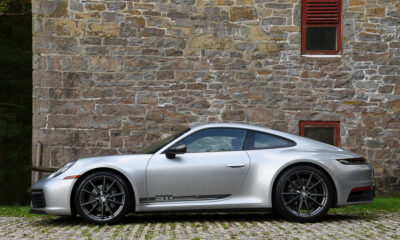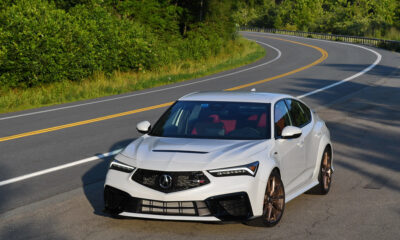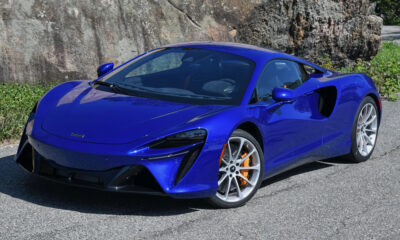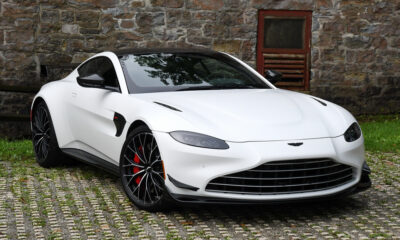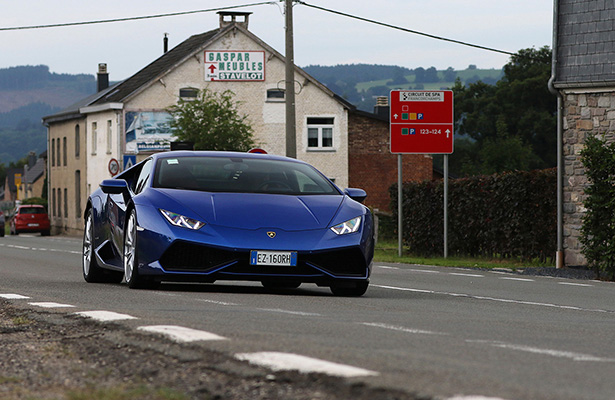
All Photos: Vincent Wouters
While there’s been a new wave of GT3 cars introduced over the last 12 months, their road-going counterparts have been equally impressive, and oftentimes exceeding the performance levels of the track-developed GT machines.
Case in point, the new Lamborghini Huracán LP 610-4, the all-new Italian bull from Sant’Agata, packs nearly 100 additional horsepower than the new-for-2015 Huracán GT3 race car, due to the FIA’s Balance of Performance regulations.
It makes the 602-horsepower Huracán production car feel like a rocket ship on wheels, and a serious threat on the street to the established likes of Ferrari’s 488 GTB or the McLaren 650S in the battle of the supercars.
Launched at the 2014 Geneva Motor Show as the successor to the Lamborghini Gallardo, the Huracán delivers on a number of key improvements, specifically in performance, styling and drivability.
The aluminum-carbon chassis results in a reduced weight of 3,135 pounds, marking a 50 percent increase in stiffness over the Gallardo, while the seven-speed dual-clutch transmission, also new, provides improved shifting characteristics.
From the flip of the fighter jet-like ignition switch, the Huracán fires to life, with three different driving modes (Strada, Sport, Corsa) available, each tailored for specific purposes.
In our test drive during last month’s 24 Hours of Spa weekend, we took the car out onto the historic old circuit, which at 8.7 miles in length, is still mostly drivable through public roads winding through the villages of Burnenville and Stavelot.
While unable to test the Huracán’s top speed of 202 mph in the Belgian countryside, the car’s all-wheel drive kept it firmly planted to the ground, with a surprising level of grip through the varying types of surfaces.
Cruising in Strada (street) mode gave a smooth ride, while a flip of a switch to Sport or Corsa fully unleashed the 5.2-liter V10 powerplant and shifted into a stiffer, race-inspired suspension mode, while also providing a higher RPM limit through the all-digital dash.
There’s no mistaking the iconic engine note of a Lamborghini, and the Huracán is no exception, despite the powertrain having been shared with the Audi R8.
As was the case with the Gallardo, both cars were developed on the same platform, although even the second-generation R8 is no match for the Huracán in terms of performance, but comes in at nearly half the price of Lamborghini’s $241,945 base.
According to Lamborghini R&D Director Maurizio Reggiani, one of the main focus points was making the Huracán a more versatile car for different types of drivers, but not coming at a sacrifice other areas.
“We’ve really improved because the Huracán is much more of a daily usable car,” Reggiani told Sportscar365. “With the double clutch and dynamic steering, you’re able to use the car in every condition in a really friendly and comfortable way.
“Everybody from young people to women or old people can use the car without having any kind of trouble or worry.
“You can select Strada mode, which is automatic, is more like a normal premium car. You can then put it in Corsa and have manual shifts and a car that’s ready to race at a track like Spa.”
The other unique aspect of the car’s development was that it was designed alongside the Huracán LP 620-2 Super Trofeo and Huracán GT3 cars, a first for the small Italian manufacturer.
“When we started the development of the Huracán, what was really strategic was the decision to launch the development, not only of the street version but also the two race cars,” Reggiani explained.
“It was easier to plan the future of all the three cars and we were able to put the development in parallel with no compromises.”
Reggiani said all three models underwent development in parallel for nearly three years, prior to the launch of the production car in mid-2014 and the Super Trofeo and GT3 models making on-track debuts later that year.
“For us, this was the first time we approached a project so complex in parallel,” he said.
“I think the final result has been really great because we were able to put the street car, the Super Trofeo and GT3 car in the same year. That’s something really unique.”
Each model has already proven to be a hit, with the Huracán GT3 winning in its debut race at Monza, and more than 50 of the LP 620-2 Super Trofeo cars having been built for the popular single-make series in Europe, North America and Asia.
A total of 14,000 Gallardos were produced during its 10-year cycle, and given the high level of interest, both on and off the track, the Huracán is expected to exceed those numbers, in what could be one of Lamborghini’s most successful supercars.
Judging by our first impressions, there’s no doubt the Huracán has a bright future, and with lessons learned on the race track being translated into further enhancements to the production platform, the fun is just getting started.



















